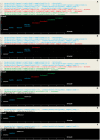Symbolic Modeling of Asynchronous Neural Dynamics Reveals Potential Synchronous Roots for the Emergence of Awareness
- PMID: 30809141
- PMCID: PMC6380086
- DOI: 10.3389/fncom.2019.00001
Symbolic Modeling of Asynchronous Neural Dynamics Reveals Potential Synchronous Roots for the Emergence of Awareness
Abstract
A new computational framework implementing asynchronous neural dynamics is used to address the duality between synchronous vs. asynchronous processes, and their possible relation to conscious vs. unconscious behaviors. Extending previous results on modeling the first three levels of animal awareness, this formalism is used here to produce the execution traces of parallel threads that implement these models. Running simulations demonstrate how sensory stimuli associated with a population of excitatory neurons inhibit in turn other neural assemblies i.e., a kind of neuronal asynchronous wiring/unwiring process that is reflected in the progressive trimming of execution traces. Whereas, reactive behaviors relying on configural learning produce vanishing traces, the learning of a rule and its later application produce persistent traces revealing potential synchronous roots of animal awareness. In contrast, to previous formalisms that use analytical and/or statistical methods to search for patterns existing in a brain, this new framework proposes a tool for studying the emergence of brain structures that might be associated with higher level cognitive capabilities.
Keywords: asynchronous process; emergence of awareness; neural dynamics; symbolic modeling; synchronous process.
Figures











Similar articles
-
Towards neuro-inspired symbolic models of cognition: linking neural dynamics to behaviors through asynchronous communications.Cogn Neurodyn. 2017 Aug;11(4):327-353. doi: 10.1007/s11571-017-9435-3. Epub 2017 Apr 1. Cogn Neurodyn. 2017. PMID: 28761554 Free PMC article.
-
[Dynamic paradigm in psychopathology: "chaos theory", from physics to psychiatry].Encephale. 2001 May-Jun;27(3):260-8. Encephale. 2001. PMID: 11488256 French.
-
Properties of synchronous and asynchronous release during pulse train depression in cultured hippocampal neurons.J Neurophysiol. 2001 Jun;85(6):2324-34. doi: 10.1152/jn.2001.85.6.2324. J Neurophysiol. 2001. PMID: 11387379
-
The labile brain. I. Neuronal transients and nonlinear coupling.Philos Trans R Soc Lond B Biol Sci. 2000 Feb 29;355(1394):215-36. doi: 10.1098/rstb.2000.0560. Philos Trans R Soc Lond B Biol Sci. 2000. PMID: 10724457 Free PMC article. Review.
-
Metastability of Synchronous and Asynchronous Dynamics.Entropy (Basel). 2022 Mar 24;24(4):450. doi: 10.3390/e24040450. Entropy (Basel). 2022. PMID: 35455114 Free PMC article. Review.
Cited by
-
From pixels to prognosis: leveraging radiomics and machine learning to predict IDH1 genotype in gliomas.Neurosurg Rev. 2025 Apr 29;48(1):396. doi: 10.1007/s10143-025-03515-z. Neurosurg Rev. 2025. PMID: 40299088 Free PMC article.
-
In a visual inverted pendulum balancing task avoiding impending falls gets harder as we age.Exp Brain Res. 2025 Jan 16;243(2):44. doi: 10.1007/s00221-025-06997-x. Exp Brain Res. 2025. PMID: 39815126 Free PMC article.
-
Grounding Mental Representations in a Virtual Multi-Level Functional Framework.J Cogn. 2023 Jan 12;6(1):6. doi: 10.5334/joc.249. eCollection 2023. J Cogn. 2023. PMID: 36698786 Free PMC article.
-
Modeling the Synchronization of Multimodal Perceptions as a Basis for the Emergence of Deterministic Behaviors.Front Neurorobot. 2020 Dec 3;14:570358. doi: 10.3389/fnbot.2020.570358. eCollection 2020. Front Neurorobot. 2020. PMID: 33424574 Free PMC article.
References
-
- Baars B. A. (1988). Cognitive Theory of Consciousness. Cambridge, UK: Cambridge University Press.
-
- Besold T., Kühnberger K. (2015). Towards integrated neural–symbolic systems for human level AI: two research programs helping to bridge the gaps. Biol. Ins. Cogn. Arch. 14, 97–110. 10.1016/j.bica.2015.09.003 - DOI
-
- Bonzon P. (1997). “A reflective proof system for reasoning in contexts,” in Proc AAAI97. Available online at: www.aaai.org/Papers/AAAI/1997/AAAI97-061.pdf
LinkOut - more resources
Full Text Sources

